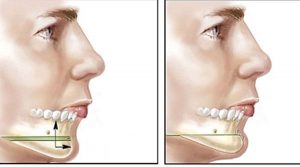Chin surgery, or mentoplasty, is a surgical procedure to reshape the chin either by enhancement with an implant or reduction surgery on the bone.
Plastic surgery, and other minor office procedures, can often be performed on the lower jaw line and chin area to improve proportions of the face and to help with one’s confidence and self-esteem. These types of interventions are frequently suggested by board-certified plastic surgeons to improve the harmony of facial features and improve the chin/jaw/cheek/forehead balance.
Sometimes bone from the jaw itself can be moved forward in an operation called a mentoplasty or genioplasty. Alternatively, shaped silicone implants can be used to give more projection to the chin.
Conversely, bone can be removed to decrease an overly projecting chin. Furthermore, modifications to the upper and/or lower jaw can be advised for improved chewing dynamics and occlusion—or how the teeth fit together. These operations can range from simple to very complex.
Many times a plastic surgeon may recommend chin surgery or procedures to a patient having a rhinoplasty in order to achieve better facial proportions, as the size of the chin may magnify or minimize the perceived size of the nose.
Candidates for Chin Surgery
Chin surgery is cosmetic surgery to balance facial proportions and improve appearance. Chin surgery can help people who have:
- Receding or “weak” chins
- Poor occlusion (the way teeth fit together) such as an overbite or underbite (Accompanied dental work or further surgery may be needed to fix the occlusion)
- Asymmetry, in which the chin is pushed to one side
- Overprojecting or “long” chins
What to Expect From a Chin Surgery
A chin lift is an outpatient procedure, and patients can go home the same day. In the first step, our surgeons discuss anesthesia options with patients to provide comfort during the procedure. We typically use general anesthesia, but sometimes we use a local anesthesia to numb the chin area, along with sedation medication to help patients relax.
In the second step for a chin implantation, the surgeon makes an incision either inside the mouth or under the chin. The surgeon creates a pocket in front of the chin and under the muscles to hold the implant and then inserts the implant, which can be either bone or made of silicone or other synthetic material. The implant is usually attached to the bone with screws or stitches.
For a sliding genioplasty, the surgeon makes an incision inside the mouth to access the chin bone. Using a bone saw, the surgeon cuts through the jawbone, then moves it to its desired position. The jawbone is reattached using wires, small plates, or screws to hold it in place.
Chin shaving is done with either an incision in the mouth or under the chin and uses a specialized burr to shave the excess bone.
The third step for both procedures has the surgeon closing the incisions using sutures, skin adhesives, or tapes. If the incision was inside the mouth, patients will have no visible scars.
During their recovery, patients can expect to:
- Receive medication to relieve discomfort and soreness for a few days after the procedure
- Have some swelling, numbness, or a stretching sensation around the chin for about one week; most swelling goes away in about six weeks
- Return to work and most activities within seven to 10 days
- Resume more strenuous activities after a few weeks
